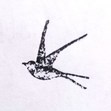Environments and Observations
Crumbling watchtowers, standing alone on windswept headlands. Great circles of stone like fallen amphitheatres, where flowing magma once met the sea. Island fortresses whose walls are still strong, because they’ve never actually fired a shot in anger. Smooth-walled caves, whose stone seems to have grown like a living thing.
I’m not talking about something I’ve written – not yet. I’m talking about South Wales.
 St Catherine’s Fort, Tenby
St Catherine’s Fort, TenbyI’ve just been in Pembrokeshire for a week with my family, trying to work off many large and delicious meals by walking – and occasionally climbing – many miles across the endless expanses of sand and stone that are the Welsh beaches. But just because I was on holiday doesn’t mean my writer’s brain wasn’t at work. I was in a new environment, after all. (Well, new-ish: having grown up in the Marches with half my family in Wales and the other first in Eastbourne, then Devon, I’ve spent a lot of time around castles and British beaches.) And a new environment means new inspirations – which means it’s time for reference photos to be taken, and for the ‘Environmental Observations and Other Such Stuff’ notebook to come out and play.
(I’ve talked about this before, but just as it’s always relevant to make notes like these, it’s always relevant to mention it again.)
I put a lot in this notebook. I make notes about interesting buildings, like the aforementioned watchtower: the remains of Tenby Castle, a single Norman tower overlooking a glorious view of a vast harbour; or the neighbouring St Catherine’s Fort, which looks unassailable, and has in fact never been assailed. But there are also far more seemingly random things: a section of ruined wall on a beach, an abandoned farmhouse. There are no blue plaques or information boards for things like these: there’s just what I can write down or sketch out. It makes them all the more appealing.
 Near Saundersfoot. Look, was I supposed to not climb through the ruined wall?
Near Saundersfoot. Look, was I supposed to not climb through the ruined wall?I make notes about local cultures, past and present. It’s Wales, so it was mining: coal and iron, a lot of which is still visible in the cliffs or underfoot. (Or underhand, as I climbed across a slope of it. It tasted like coal, anyway.) There are rail tunnels for steam-engines, memorials to old disasters, old pit-sites marked on maps. I take note of amusing or interesting place-names, or place-names that could become people’s names, or vice-versa. I make notes on the natural environment: the towering cliffs, the amazing caves that look like they’re straight out of Doctor Who, with their eerily organic weathered stone. I take pictures. I remember.
 Seriously, look at this stuff. It’s so cool.
Seriously, look at this stuff. It’s so cool.And yes, I do make notes on the weather: in this case, cold and damp, but with occasional bouts of glorious sunshine to take the sting out of the salt breeze coming off the sea. It may seem mundane, but even that is useful.
Because later – maybe a few days later, maybe months or even years later, I’ll be sitting at my keyboard and trying to think of how to describe a mine, or a fort, or a sleepy little village on the coast. I’ll be trying to write about a walk on the beach – or maybe a ship at sea on freezing (or more likely boiling) waves. And my imagination will get me so far. I’ll have the shape of the walls, or I’ll be able to describe the waves, or I’ll have a miner in mind. But I might not have the weather right. I might not be able to think of what scents are on the air. I might not have a good name.
At which point, I’ll open that notebook, and look at those photos, and I’ll find everything I need. Because these are the little things that make good writing great, the things that really immerse you in a story: not grandiose descriptions, not elaborate backstories, but the feel of the wind on your face and the coal-dust on your fingertips.
Wherever you go, there will be something worth remembering for later, whether it’s the weather, the view, a place itself or just its name. Take pictures. Write them down. You never know when you might need them.



